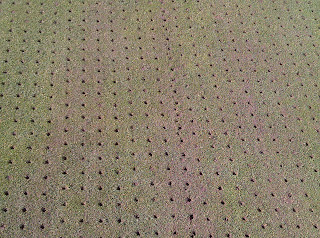One week ago, the greens here at River Bend were aerated. Comments are always the same. The greens are so nice, why are you going to punch holes all over them? Believe it or not, the reason greens perform well is because of this process. As a golf enthusiast, I can understand the less than ideal putting surface that results the first few days following an aeration event, however I also know that a heavy played golf course like River Bend needs this process to alleviate the stresses that result from our intense season. Relief of compaction, improved water penetration & percolation, better air movement withing the soil, as well as the removal of unwanted thatch are all things that aeration accomplishes.
Golfer satisfaction is directly linked to the putting surface, therefore we attempt to minimize the time it takes to recover following aeration as much as possible. Through pre and post fertilization practices we encourage growth; heavy topdressing and brushing helps fill the holes; and rolling trues the putting surface. Weather also drastically impacts that speed of recovery, which unfortunately, despite my best efforts, we have no control over. Warm, sunny days encourage faster recovery, however cool, damp weather will cause holes to remain niticeable much longer.
Golfer satisfaction is directly linked to the putting surface, therefore we attempt to minimize the time it takes to recover following aeration as much as possible. Through pre and post fertilization practices we encourage growth; heavy topdressing and brushing helps fill the holes; and rolling trues the putting surface. Weather also drastically impacts that speed of recovery, which unfortunately, despite my best efforts, we have no control over. Warm, sunny days encourage faster recovery, however cool, damp weather will cause holes to remain niticeable much longer.
Here is a link that explains the agronomically benefits in much more depth.
Below are some photos of the lengthy process that took place last week.
Hollow Tine Aeration






No comments:
Post a Comment